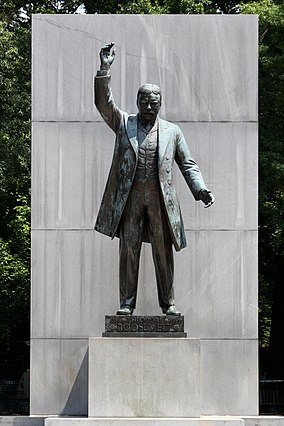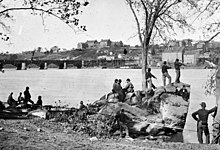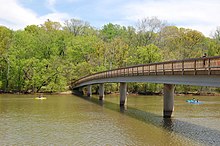Theodore Roosevelt Island
| Theodore Roosevelt Island National Memorial | |
|---|---|
 17-foot Centerpiece Statue | |
| Location | The Potomac River in Washington, D.C., U.S. |
| Coordinates | 38°53′50″N 77°3′51″W / 38.89722°N 77.06417°W |
| Area | 88.5 acres (35.8 ha) |
| Max. elevation | 44 feet (13 m) |
| Established | May 21, 1932 |
| Visitors | 160,000 (in 2015 [1]) |
| Governing body | National Park Service |
| Website | Theodore Roosevelt Island |
Theodore Roosevelt Island is an 88.5-acre (358,000 m2) island and
The island is maintained by the
According to the National Park Service: "In the 1930s landscape architects transformed Mason’s Island from neglected, overgrown farmland into Theodore Roosevelt Island, a memorial to America’s 26th president. They conceived a 'real forest' designed to mimic the natural forest that once covered the island. Today miles of trails through wooded uplands and swampy bottomlands honor the legacy of a great outdoorsman and conservationist."[5]
A small island,
History
Early history
The Nacotchtank Indians, formerly of what is now Anacostia (in Washington, D.C.), temporarily moved to the island in 1668, giving its first recorded name, "Anacostine". The island was patented in 1682 as Anacostine Island by Captain Randolph Brandt (or Brunett), who left the island to his daughter Margaret Hammersley, upon his death in 1698 or 1699.[6][7]
Mason, Carter, and Bradley families
The island was acquired by

John Mason built a mansion on the island around 1796 and planted crops for sale as well as gardens. The home was built and estate maintained with free black and slave labor. He was an active member of the Agricultural Society of Georgetown and the Columbia Agricultural Society of Washington, and able to manufacture almost everything needed for home consumption (including cotton) on the island.[10] He also entertained lavishly on the island,[11] including a 1798 party to honor then-uncrowned Louis Philippe I, and an 1811 fete for his son John Murray Mason before he left to study in Paris.[12] In 1809 John Mason secured a charter for a turnpike to connect his ferry landing with the Washington-Alexandria turnpike that Congress had chartered the previous year (and which would follow what became U.S. Route 1 and compete with his ferry for traffic).[13] John Mason also diversified his income-producing activities, operating a ferry between Georgetown and the Virginia shore until construction of the Aqueduct Bridge in 1843 (superseded by the Key Bridge in 1923),[14][15] as well as from 1817 until 1838 serving as the last president of the Potowmack Company (founded in 1774 with George Washington as its first President and in order to deepen the Potomac's channel and build locks around the principal falls).[16]
Using federal funds and private funds raised by Georgetown merchants, a causeway from the Virginia shore to the island was constructed after debris from flooding in the winter of 1784 changed the Potomac River's main channel from the island's western side to the eastern side and increased silt which threatened the nearby Georgetown port.[17][18] Alexandria merchants objected to the causeway and it proved a sticking point in their calls for retrocession of 26 square miles of land Virginia had given to establish the federal city as the century began. The first retrocession attempt was in 1804, and another major failed attempt occurred in 1824.[19] However, by 1831, water stagnation caused the Mason family to move from the island. (Through his ownership, John Mason, who opposed retrocession, also had a Georgetown residence at the corner of 25th Street, L Street and Pennsylvania Avenue, which became the site of Columbia Hospital in 1932).[20] In 1842, then elderly John Mason sold the island to John Carter.[7] Four years later, Congress left retrocession to a referendum, which President James K. Polk authorized and Alexandria voters endorsed by a 763 to 222 vote on September 1, 1846 (despite opposition from the northern areas). After a further year of Congressional and Virginia General Assembly negotiations, the island became part of Alexandria County (the northern portion later separated from the City of Alexandria and was renamed Arlington County).[21][22] After Carter died in 1851, the island passed to William A. Bradley.[7] Nonetheless, in 1854, the island again hosted an entertainment, this time given by the late John Mason's daughter Anna Maria (who had married Sydney Smith Lee in 1834) to mark a treaty opening Japan to foreign trade (Captain Lee having served under Commodore Matthew C. Perry on the voyage which resulted in the treaty).[20]
American Civil War


In 1861, Alexandria County had about 10,000 residents, three-quarters of whom lived in the city portion, and about half of those in the country portion were enslaved or "free colored".
Test site and gas light company
Following the declaration of war against Spain in 1898, the island became a test site for a number of private experiments in electrical ignition of the explosives dynamite and joveite led by the chemist Charles Edward Munroe of Columbian University.[28] Monroe's experiments, which explored the use of the explosives for mining waterways and roadways and preparing ground for rapid entrenchment, were conducted in secret and without alerting the District of Columbia Police Department, which investigated citizens' reports of Spanish spy activity and found the explosives and detonators buried on the island.[28]
From 1913 to 1931,
National memorial

In 1931, the Theodore Roosevelt Memorial Association purchased the island from the gas company with the intention of erecting a
authorized the memorial on May 21, 1932, but did not appropriate funds for the memorial for almost three decades.Funds were finally designated by Congress in 1960. As with all historic areas administered by the National Park Service, the national memorial is listed on the National Register of Historic Places; the listing first appeared on October 15, 1966.
The memorial was dedicated on October 27, 1967.[30] Designed by Eric Gugler, the memorial includes a 17-foot (5.2 m) statue by sculptor Paul Manship, four large stone monoliths with some of Roosevelt's more famous quotations, and two large fountains.
Geography and natural history


The Potomac River surrounding the island is at sea level, part of the
The rocky western (upriver) and central portions of the island are part of the
Spring floods coming down the Potomac from
The island's
The island is particularly known for its variety of birds and its showy displays of spring wildflowers. However, dozens of non-native invasive plants have become abundant there, often outcompeting the native species.
Access

Theodore Roosevelt Island is accessible by a footbridge from a parking lot along the Virginia bank of the Potomac River, just north of the Theodore Roosevelt Bridge, which crosses but does not allow access to the island. Cars can enter this parking lot only from the northbound lanes of the George Washington Memorial Parkway.
Pedestrians can reach the parking lot and footbridge by following the
Several hiking trails provide access to the memorial and a variety of the island's natural habitats, including a boardwalk through a swampy and marshy area.[3]
In popular culture
- A story by Ernest Seton Thompson"The Royal Analostan" mentions the island as the origin of the fictional cat breed.
- The 2014 movie Captain America: The Winter Soldier depicted Little Island as the site of the Triskelion, the headquarters of the fictional S.H.I.E.L.D. spy agency.[32]
- In 2019 video game Tom Clancy's The Division 2 the island was the site of a failed quarantine effort after the outbreak of a manufactured epidemic disease. The citizens quarantined on the island radicalized into a group called the "Outcasts", one of the game's major antagonist factions.
See also
- List of national memorials of the United States
- List of islands of the United States
- List of islands on the Potomac River
- List of sculptures of presidents of the United States
- Presidential memorials in the United States
References
- ^ [1]
- ^ National Park Service. "Listing of area as of 09/30/2005" (PDF). Archived from the original (PDF) on October 14, 2006. Retrieved May 5, 2006.
- ^ a b c d "Theodore Roosevelt Island". U.S. National Park Service. Retrieved 25 June 2011.
- ^ "Theodore Roosevelt Island". U.S. Geographic Survey: Geographic Names Information System. Retrieved 2009-01-13.
- ^ "Theodore Roosevelt Island (U.S. National Park Service)". www.nps.gov. Retrieved 2016-02-29.
- ^ a b c d Curry, Mary E. (1971–1972). "Theodore Roosevelt Island: A Broken Link to Early Washington, D.C. History". Records of the Columbia Historical Society.
- ^ a b c Proctor, John Clagett (1949). Proctor's Washington and Environs. John Clagett Proctor, LL.D. p. 98.
- ^ James W. Foster, "Potomac River Maps of 1737 by Robert Brooke and Others," William and Mary College Quarterly Historical Magazine 2nd Ser., Vol. 18, No. 4. (October 1938), 410.
- ^ Cornelia B. Rose Jr. (1976). Arlington County, Virginia: a history. Arlington Historical Society. p. 46
- ^ Nan Netherton, Donald Sweig, Janice Artemel, Patricia Hickin and Patrick Reed, Fairfax County, Virginia: a history, Fairfax County Board of Supervisors 1978 (ISBN 0-9601630-1-8) p. 165
- ^ Sherman Pratt, Arlington County, Virginia: a Modern History (Arlington Historical Society 1997) p. 14
- ^ Pamela C. Copeland and Richard K. MacMaster, The Five George Masons (Board of Regents of Gunston Hall by University of Virginia Press 1975) p. 258
- ^ Rose p. 76
- ^ Netherton, p. 185
- ^ Rose p. 47
- ^ Rose pp. 78-79
- ^ NPS signage at the island
- ^ Rose pp. 47, 80
- ^ Pratt p. 174
- ^ a b Copeland p. 258
- ^ Rose pp. 80-82
- ^ Pratt pp. 12, 175-177
- ^ Pratt, p. 13
- ^ Rose p. 99
- ^ "Aboard the Underground Railroad - Rush R. Sloane House". www.nps.gov. Retrieved 2021-06-02.
- ISBN 9781107002326.
- ^ "Theodore Roosevelt Island". worldsiteguides.com. Retrieved 2016-02-29.
- ^ a b Brooks, Edward M. (21 May 1898). "Trials With Explosives". Boston Evening Transcript. Retrieved 14 August 2014.
- ^ NPS signage on the island
- ^ The National Parks: Index 2001–2003. Washington: U.S. Department of the Interior.
- ^ "NPS: Theodore Roosevelt Island".
- ^ Merchant, Canaan (February 7, 2014). "Captain America obliterates Rosslyn and Roosevelt Island". Greater Greater Washington. Retrieved July 16, 2015.
External links
- Official website
- Theodore Roosevelt Association
- Historic American Landscapes Survey (HALS) No. DC-12, "Theodore Roosevelt Island"
- Historic American Buildings Survey (HABS) No. DC-28, "General John Mason House", formerly located on island
- Friends of Theodore Roosevelt Island


